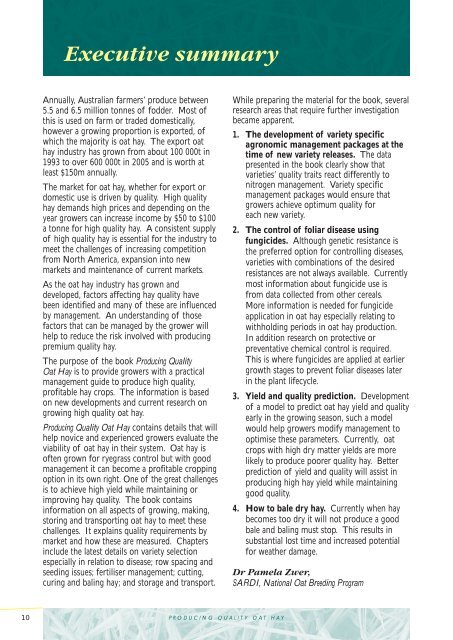Create successful ePaper yourself
Turn your PDF publications into a flip-book with our unique Google optimized e-Paper software.
Executive summary<br />
Annually, Australian farmers’ produce between<br />
5.5 and 6.5 million tonnes of fodder. Most of<br />
this is used on farm or traded domestically,<br />
however a growing proportion is exported, of<br />
which the majority is oat hay. The export oat<br />
hay industry has grown from about 100 000t in<br />
1993 to over 600 000t in 2005 and is worth at<br />
least $150m annually.<br />
The market for oat hay, whether for export or<br />
domestic use is driven by quality. High quality<br />
hay demands high prices and depending on the<br />
year growers can increase income by $50 to $100<br />
a tonne for high quality hay. A consistent supply<br />
of high quality hay is essential for the industry to<br />
meet the challenges of increasing competition<br />
from North America, expansion into new<br />
markets and maintenance of current markets.<br />
As the oat hay industry has grown and<br />
developed, factors affecting hay quality have<br />
been identified and many of these are influenced<br />
by management. An understanding of those<br />
factors that can be managed by the grower will<br />
help to reduce the risk involved with producing<br />
premium quality hay.<br />
The purpose of the book <strong>Producing</strong> <strong>Quality</strong><br />
<strong>Oat</strong> <strong>Hay</strong> is to provide growers with a practical<br />
management guide to produce high quality,<br />
profitable hay crops. The information is based<br />
on new developments and current research on<br />
growing high quality oat hay.<br />
<strong>Producing</strong> <strong>Quality</strong> <strong>Oat</strong> <strong>Hay</strong> contains details that will<br />
help novice and experienced growers evaluate the<br />
viability of oat hay in their system. <strong>Oat</strong> hay is<br />
often grown for ryegrass control but with good<br />
management it can become a profitable cropping<br />
option in its own right. One of the great challenges<br />
is to achieve high yield while maintaining or<br />
improving hay quality. The book contains<br />
information on all aspects of growing, making,<br />
storing and transporting oat hay to meet these<br />
challenges. It explains quality requirements by<br />
market and how these are measured. Chapters<br />
include the latest details on variety selection<br />
especially in relation to disease; row spacing and<br />
seeding issues; fertiliser management; cutting,<br />
curing and baling hay; and storage and transport.<br />
10 PRODUCING QUALITY OAT HAY<br />
While preparing the material for the book, several<br />
research areas that require further investigation<br />
became apparent.<br />
1. The development of variety specific<br />
agronomic management packages at the<br />
time of new variety releases. The data<br />
presented in the book clearly show that<br />
varieties’ quality traits react differently to<br />
nitrogen management. Variety specific<br />
management packages would ensure that<br />
growers achieve optimum quality for<br />
each new variety.<br />
2. The control of foliar disease using<br />
fungicides. Although genetic resistance is<br />
the preferred option for controlling diseases,<br />
varieties with combinations of the desired<br />
resistances are not always available. Currently<br />
most information about fungicide use is<br />
from data collected from other cereals.<br />
More information is needed for fungicide<br />
application in oat hay especially relating to<br />
withholding periods in oat hay production.<br />
In addition research on protective or<br />
preventative chemical control is required.<br />
This is where fungicides are applied at earlier<br />
growth stages to prevent foliar diseases later<br />
in the plant lifecycle.<br />
3. Yield and quality prediction. Development<br />
of a model to predict oat hay yield and quality<br />
early in the growing season, such a model<br />
would help growers modify management to<br />
optimise these parameters. Currently, oat<br />
crops with high dry matter yields are more<br />
likely to produce poorer quality hay. Better<br />
prediction of yield and quality will assist in<br />
producing high hay yield while maintaining<br />
good quality.<br />
4. How to bale dry hay. Currently when hay<br />
becomes too dry it will not produce a good<br />
bale and baling must stop. This results in<br />
substantial lost time and increased potential<br />
for weather damage.<br />
Dr Pamela Zwer,<br />
SARDI, National <strong>Oat</strong> Breeding Program

















